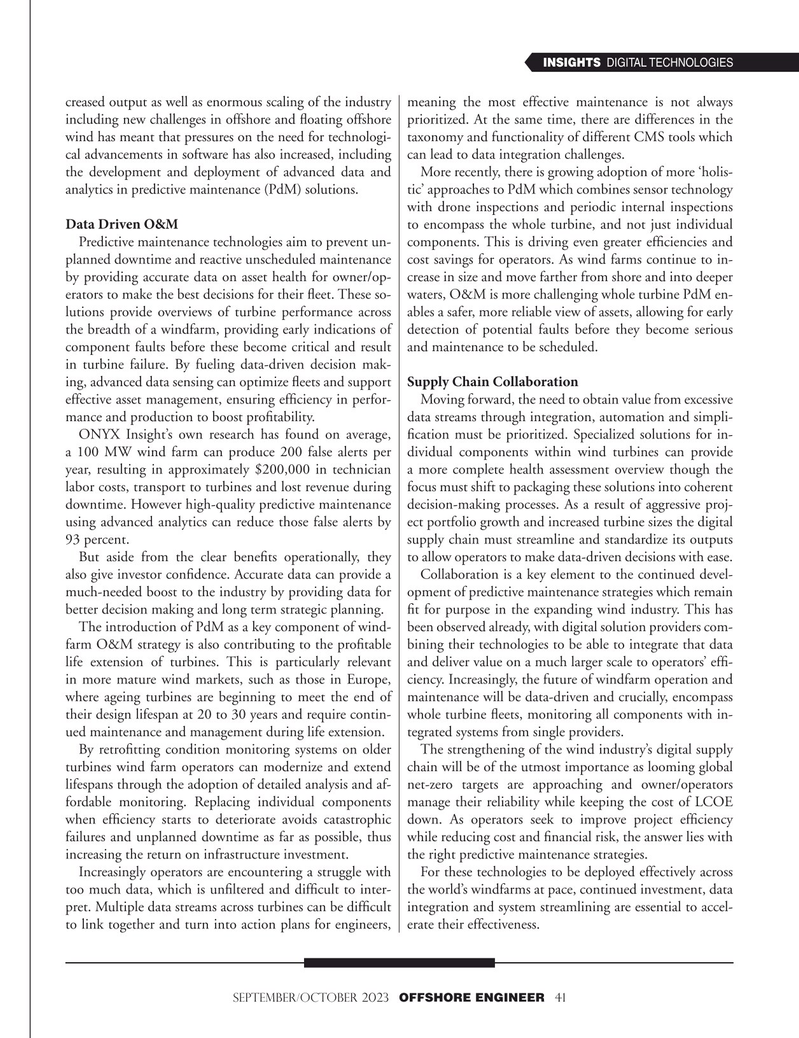
Page 40: of Offshore Engineer Magazine (Sep/Oct 2023)
Read this page in Pdf, Flash or Html5 edition of Sep/Oct 2023 Offshore Engineer Magazine
INSIGHTS DIGITAL TECHNOLOGIES creased output as well as enormous scaling of the industry meaning the most effective maintenance is not always including new challenges in offshore and ?oating offshore prioritized. At the same time, there are differences in the wind has meant that pressures on the need for technologi- taxonomy and functionality of different CMS tools which cal advancements in software has also increased, including can lead to data integration challenges.
the development and deployment of advanced data and More recently, there is growing adoption of more ‘holis- analytics in predictive maintenance (PdM) solutions. tic’ approaches to PdM which combines sensor technology with drone inspections and periodic internal inspections
Data Driven O&M to encompass the whole turbine, and not just individual
Predictive maintenance technologies aim to prevent un- components. This is driving even greater ef?ciencies and planned downtime and reactive unscheduled maintenance cost savings for operators. As wind farms continue to in- by providing accurate data on asset health for owner/op- crease in size and move farther from shore and into deeper erators to make the best decisions for their ?eet. These so- waters, O&M is more challenging whole turbine PdM en- lutions provide overviews of turbine performance across ables a safer, more reliable view of assets, allowing for early the breadth of a windfarm, providing early indications of detection of potential faults before they become serious component faults before these become critical and result and maintenance to be scheduled.
in turbine failure. By fueling data-driven decision mak- ing, advanced data sensing can optimize ?eets and support Supply Chain Collaboration effective asset management, ensuring ef?ciency in perfor- Moving forward, the need to obtain value from excessive mance and production to boost pro?tability. data streams through integration, automation and simpli-
ONYX Insight’s own research has found on average, ?cation must be prioritized. Specialized solutions for in- a 100 MW wind farm can produce 200 false alerts per dividual components within wind turbines can provide year, resulting in approximately $200,000 in technician a more complete health assessment overview though the labor costs, transport to turbines and lost revenue during focus must shift to packaging these solutions into coherent downtime. However high-quality predictive maintenance decision-making processes. As a result of aggressive proj- using advanced analytics can reduce those false alerts by ect portfolio growth and increased turbine sizes the digital 93 percent. supply chain must streamline and standardize its outputs
But aside from the clear bene?ts operationally, they to allow operators to make data-driven decisions with ease.
also give investor con?dence. Accurate data can provide a Collaboration is a key element to the continued devel- much-needed boost to the industry by providing data for opment of predictive maintenance strategies which remain better decision making and long term strategic planning. ?t for purpose in the expanding wind industry. This has
The introduction of PdM as a key component of wind- been observed already, with digital solution providers com- farm O&M strategy is also contributing to the pro?table bining their technologies to be able to integrate that data life extension of turbines. This is particularly relevant and deliver value on a much larger scale to operators’ ef?- in more mature wind markets, such as those in Europe, ciency. Increasingly, the future of windfarm operation and where ageing turbines are beginning to meet the end of maintenance will be data-driven and crucially, encompass their design lifespan at 20 to 30 years and require contin- whole turbine ?eets, monitoring all components with in- ued maintenance and management during life extension. tegrated systems from single providers.
By retro?tting condition monitoring systems on older The strengthening of the wind industry’s digital supply turbines wind farm operators can modernize and extend chain will be of the utmost importance as looming global lifespans through the adoption of detailed analysis and af- net-zero targets are approaching and owner/operators fordable monitoring. Replacing individual components manage their reliability while keeping the cost of LCOE when ef?ciency starts to deteriorate avoids catastrophic down. As operators seek to improve project ef?ciency failures and unplanned downtime as far as possible, thus while reducing cost and ?nancial risk, the answer lies with increasing the return on infrastructure investment. the right predictive maintenance strategies.
Increasingly operators are encountering a struggle with For these technologies to be deployed effectively across too much data, which is un?ltered and dif?cult to inter- the world’s windfarms at pace, continued investment, data pret. Multiple data streams across turbines can be dif?cult integration and system streamlining are essential to accel- to link together and turn into action plans for engineers, erate their effectiveness.
september/october 2023 OFFSHORE ENGINEER 41

 39
39

 41
41